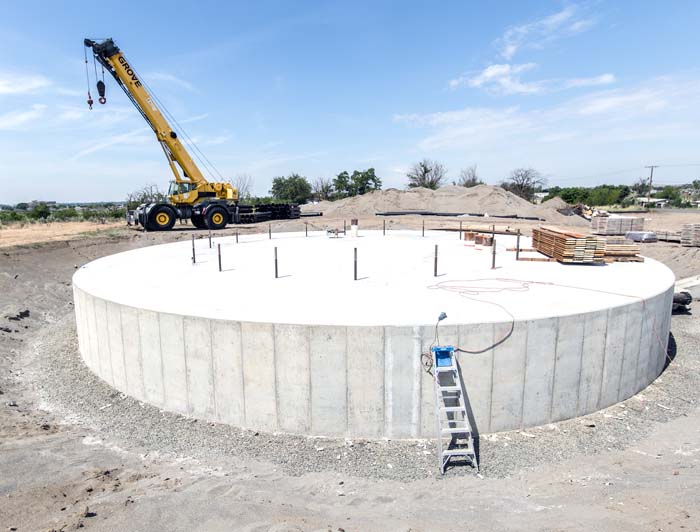PERS continues to eat into city budget
Published 4:00 am Friday, May 31, 2019

- A 1 million-gallon water tower is one of the City of Hermiston’s biggest capital improvement projects for the 2019-20 fiscal year.
As Hermiston city officials budget for the coming fiscal year, the costs of the Public Employee Retirement System continue to grow.
City manager Byron Smith wrote in the forward to the proposed 2019-20 budget that the city’s general fund was seeing a 25% increase in PERS costs, on top of steep increases over the past few years.
“This will not be sustainable for many more years,” he said. “This increase is eating up most if not all of our revenue growth.”
In the police department, for example, PERS expenses are increasing by $210,000. Police Chief Jason Edmiston said the continued increases restrict his ability to add new personnel.
The city council will vote on the 2019-20 budget during their June 10 meeting. The budget includes a 2.75% cost of living increase for employees, and maintains current staffing levels at the equivalent of 120 full-time employees.
Capital projects
While Hermiston will continue its investment into new capital improvement projects over the next year, many of the projects slated for 2019-20 will be less visible than recent undertakings such as the new senior center. The city plans to upgrade the computer system that runs its water and sewer system, improve a well and a lift station, replace underground storage tanks and expand the Geer Road water line.
The biggest water-related project continuing into 2019-20 is construction of the city’s new 1 million-gallon water tank on Punkin Center, which will boost the city’s storage capacity and open up hundreds of acres for development.
On the street side, funds are being put toward an overlay of West Hermiston Avenue, East Theater Lane paving, and design work on the planned realignment of the confusing three-way intersection between Geer, Harper and Umatilla River roads.
Police department
Changes to the Hermiston Police Department budget signal changes to how officers complete their work.
The department is following a previous move by the rest of the city to lease vehicles from Enterprise instead of purchasing them outright. Edmiston said part of that change will be to increase the number of patrol cars — giving each patrol officer their own vehicle to park at home instead of coming to the police station and using a shared vehicle during their shift.
The new take-home policy will mean fewer marked cars in the police station lot and more parked on streets around the city, where they might inspire people to slow down or think twice about causing trouble in that neighborhood.
“There’s going to be enhanced visibility,” Edmiston said.
He said the new approach will keep the department from needing to expand its parking lot.
In the past the department has budgeted $94,000 a year to purchase two new vehicles and “upfit” them with the needed equipment. The lease on 10 additional vehicles will come in at $93,700 a year for now, and Edmiston said they will start saving substantially on that lease five years from now when the department builds up and then uses a reserve account to upfit vehicles instead of folding it into the cost of the lease. Maintenance costs are also included in the agreement with Enterprise.
Capt. Travis Eynon said studies have shown that maintenance costs go down and cars are taken better care of when each patrol officer is assigned their own vehicle.
“People tend to take a little more ownership with the take-home vehicles,” he said.
The department is also switching to department-issued cellphones. Instead of sitting in their patrol car entering notes on an in-car computer, then returning to the station to hand over a sim card full of photos for the records department to upload, officers will be able to input reports and upload photos directly from their phone on an app called iRIMS.
When incidents happen late at night, administrators will be able to log onto the system from anywhere to see reports, GPS locations of all on-duty personnel and other information.
“We can see in real time what’s going on instead of having to come in,” Edmiston said.
The app came at a one-time cost of $10,000 and the phones will cost the department about $2,000 a year, but will take away the need for $4,000 computers installed in each of the 10 new vehicles.
“It’s quick and accurate, so we also expect to save some real dollars as far as staff time,” he said.
Parks and recreation
Hermiston’s most high-profile parks project in 2019-20 will be the rebuilding of Funland Park, which burned down last month. Parks and recreation director Larry Fetter said the park was not actually included in the budget the council will look at in two weeks due to timing. Instead, the city will vote on a supplemental budget later.
“Unfortunately we don’t know what the cost will be to replace it, we don’t know what the insurance payment will be and we don’t know what the gap will be between fundraising and what’s needed,” he said.
The biggest parks project included in the budget is a skate park, which will be built on North First Street across from the police and fire stations in spring 2020 if the city secures a grant from the state that uses lottery dollars for public parks projects.
The skate park will be Phase I of a “teen adventure park.” Phase II, planned for 2021, will add a parkour area, a BMX bike track, rock climbing and other features.
The total cost of the two phases will run about $1.2 million, but grants are expected to cover about three-fourths of that cost.
The city is also working on plans for a dog park at Butte Park, south of the splash pad.
The full city budget, which will go before the city council on June 10, can be found online at hermiston.or.us/finance/budget.




